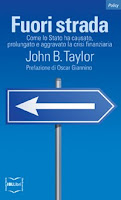An example is a November 21 news story in the New York Times with the headline “New Consensus Sees Stimulus Package as a Worthy Step.” Authors Jackie Calmes and Michael Cooper write that “the accumulation of hard data and real-life experience has allowed more dispassionate analysts to reach a consensus that the stimulus package, messy as it is, is working. The legislation, a variety of economists say, is helping an economy in free fall a year ago to grow again and shed fewer jobs than it otherwise would.”
As evidence the article includes three graphs, which are reproduced on the left of the chart below. Each of the three graphs on the left corresponds to a Keynesian model maintined by the group shown above the graph. All three graphs show that without the stimulus the recovery would be considerably weaker. The difference between the black line and the gray line is their estimated impact of the stimulus. But this difference was built-in to these models before the stimulus saw the light of day. So there are no new hard data or real life experiences here.

Now what about the so-called “consensus?” In fact, a number of other economic models predicted that the stimulus would not be very effective, and, using the same approach, those models now say that it is not very effective. To illustrate this I have added two other graphs on the right-hand side of the chart which did not appear in the New York Times article. The first one is based an a popular and well-regarded new Keynesian model estimated by Frank Smets, Director of Research at the European Central Bank, and his colleague Raf Wouters. Focus again on the difference between the black and the gray lines, which is what is predicted by that model, as shown in research by John Cogan, Volker Wieland, Tobias Cwik, and me. Note that the impact is very small. The second additional graph on the right is based on the research of Professor Robert Barro of Harvard University. As he explained last January, “when I attempted to estimate directly the multiplier associated with peacetime government purchases, I got a number insignificantly different from zero.” So according to that research, the difference between the black and the gray line should be about zero, which is what that graph shows. So there is no consensus.
Menzie Chen has a post on Econbrowser which mentioned the three graphs in the original New York Times article as an illustration of his excellent analysis of the use of counterfactuals (the gray lines in the graphs). The additional two graphs illustrate how important it is to go beyond a few models and establish robustness in policy analysis. Moreover, in my view, the models have had their say. It is now time to look at the direct impacts using hard data and real life experiences.
Menzie Chen has a post on Econbrowser which mentioned the three graphs in the original New York Times article as an illustration of his excellent analysis of the use of counterfactuals (the gray lines in the graphs). The additional two graphs illustrate how important it is to go beyond a few models and establish robustness in policy analysis. Moreover, in my view, the models have had their say. It is now time to look at the direct impacts using hard data and real life experiences.




















